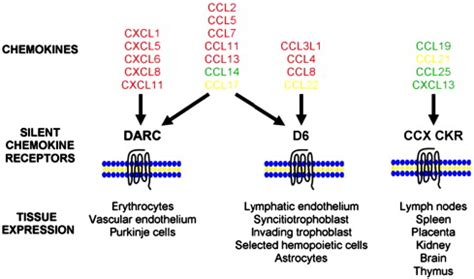Chemokines

Chemokines are members of a large family of small soluble proteins, which were discovered by their adhesion control, chemotaxis and leukocyte activation abilities. Nevertheless, it is now known they are involved in other equally important functions, namely, angiogenesis, haematopoiesis, embryologic development, B and T cell development, dendritic cell maturation, inflammation, infection, tumour growth and metastasis. Hence, the increasing interest on chemokines and their receptors is due not only to chemokine chemoattractant properties but also to their contribution to immune processes that do not directly involve leukocyte migration. According to the number and spacing of the first two conserved cysteine residues in the N-terminal, chemokines have been divided into four subfamilies (CXC, CC, CX3C and C) and mediate their functions by binding to G-protein coupled receptors. This interaction may result in multiple signal transduction pathways, depending on the player subunit and the effector protein activated. It triggers a cascade of intracellular events that promote from gene transcription to cytoskeleton rearrangement and chemotaxis. The pattern of migration of cell populations and of leukocytes in particular is closely related to chemokine receptors expression.
Product List
| Target | Catalog# | Product Name | Reactivity | Predicted MW |
|---|---|---|---|---|
| Rat CCL2 (C-6His) | PHR2396 | Recombinant Rat CCL2 (C-6His) | Rat | 14.9 kDa |
| CXCL9 (C-6His) | PHM1888 | Recombinant Mouse CXCL9 (C-6His) | Mouse | 13 KDa |
| CXCL16 (C-6His) | PHM0473 | Recombinant Mouse CXCL16 (C-6His) | Mouse | 20.1 KDa |
| CXCL1 (C-6His) | PHM0463 | Recombinant Mouse CXCL1 (C-6His) | Mouse | 9.4 KDa |
| CCL8 (C-6His) | PHM0257 | Recombinant Mouse CCL8 (C-6His) | Mouse | 9.8 KDa |
| CCL2 (C-6His) | PHM0251 | Recombinant Mouse CCL2 (C-6His) | Mouse | 14.7 KDa |
| CXCL6 (C-6His) | PHH2136 | Recombinant Human CXCL6 (C-6His) | Human | 9.35 KDa |
| CXCL9 (C-6His) | PHH0483 | Recombinant Human CXCL9 (C-6His) | Human | 12.76 KDa |
| IL-8 (C-6His) | PHH0480 | Recombinant Human IL-8 (C-6His) | Human | 10.1 KDa |
| CXCL7 (C-6His) | PHH0479 | Recombinant Human CXCL7 (C-6His) | Human | 11.3 KDa |
| CXCL4 (C-6His) | PHH0476 | Recombinant Human CXCL4 (C-6His) | Human | 8.8 KDa |
| CXCL10 (C-Fc-6His) | PHH0466 | Recombinant Human CXCL10 (C-Fc-6His) | Human | 36.6 KDa |
| CXCL1 (C-6His) | PHH0465 | Recombinant Human CXCL1 (C-6His) | Human | 8.9 KDa |
| CCL8 (C-6His) | PHH0274 | Recombinant Human CCL8 (C-6His) | Human | 9.95 KDa |
| CCL3L1 (C-6His) | PHH0271 | Recombinant Human CCL3L1 (C-6His) | Human | 8.82 KDa |
| CCL24 (C-6His) | PHH0265 | Recombinant Human CCL24 (C-6His) | Human | 11.5 KDa |
| CCL14 (C-6His) | PHH0260 | Recombinant Human CCL14 (C-6His) | Human | 9.71 KDa |
| CCL17 (C-6His) | PHH0250 | Recombinant Human CCL17 (C-6His) | Human | 9.1 KDa |
| CCL5 (N-6His) | PER0256 | Recombinant Rat CCL5 (N-6His) | Rat | 10 KDa |
| CXCL12 | PEM1576 | Recombinant Mouse CXCL12 | Mouse | 8.1 KDa |
| CXCL2 | PEM0464 | Recombinant Mouse CXCL2 | Mouse | 7.9 KDa |
| CCL9 | PEM0275 | Recombinant Mouse CCL9 | Mouse | 11.6 KDa |
| CCL21 | PEM0263 | Recombinant Mouse CCL21 | Mouse | 12.1 KDa |
| CCL3 (N-6His) | PEM0255 | Recombinant Mouse CCL3 (N-6His) | Mouse | 10.8 KDa |
| CCL24 | PEM0254 | Recombinant Mouse CCL24 | Mouse | 10.3 KDa |
| CCL2 | PEM0252 | Recombinant Mouse CCL2 | Mouse | 8.5 KDa |
| CCL1 | PEH2085 | Recombinant Human CCL1 | Human | 8.62 KDa |
| IL-8 (72AA) | PEH0482 | Recombinant Human IL-8 (72AA) | Human | 8.45 KDa |
| IL-8 (77AA) | PEH0481 | Recombinant Human IL-8 (77AA) | Human | 8.9 KDa |
| CXCL7 | PEH0478 | Recombinant Human CXCL7 | Human | 7.6 KDa |
| CXCL5 | PEH0477 | Recombinant Human CXCL5 | Human | 7.95 KDa |
| CXCL3 (N-6His) | PEH0475 | Recombinant Human CXCL3 (N-6His) | Human | 10.1 KDa |
| CXCL2 | PEH0474 | Recombinant Human CXCL2 | Human | 7.67 KDa |
| CXCL14 | PEH0471 | Recombinant Human CXCL14 | Human | 9.4 KDa |
| CXCL12 (72AA) | PEH0470 | Recombinant Human CXCL12 (72AA) | Human | 8.53 KDa |
| CXCL12 (68AA) | PEH0469 | Recombinant Human CXCL12 (68AA) | Human | 8 KDa |
| CXCL12(75AA) | PEH0468 | Recombinant Human CXCL12(75AA) | Human | 8.79 KDa |
| CXCL10 | PEH0467 | Recombinant Human CXCL10 | Human | 8.6 KDa |
| CCL8 | PEH0273 | Recombinant Human CCL8 | Human | 8.9 KDa |
| CCL5 | PEH0272 | Recombinant Human CCL5 | Human | 7.8 KDa |
| CCL3 | PEH0270 | Recombinant Human CCL3 | Human | 7.5 KDa |
| CCL28 | PEH0269 | Recombinant Human CCL28 | Human | 12.49 KDa |
| CCL27 | PEH0268 | Recombinant Human CCL27 | Human | 10.1 KDa |
| CCL26 (68AA) | PEH0267 | Recombinant Human CCL26 (68AA) | Human | 8.21 KDa |
| CCL26 (71AA) | PEH0266 | Recombinant Human CCL26 (71AA) | Human | 8.53 KDa |
| CCL23 | PEH0264 | Recombinant Human CCL23 | Human | 8.7 KDa |
| CCL18 (N-6His) | PEH0262 | Recombinant Human CCL18 (N-6His) | Human | 10.1 KDa |
| CCL11 | PEH0259 | Recombinant Human CCL11 | Human | 8.56 KDa |
| CCL2 | PEH0253 | Recombinant Human CCL2 | Human | 8.7 KDa |
Validation Data
Related Products
Super-sensitive ECL chemiluminescent reagent
References
1. The chemokines and their receptors: characteristics and physiological functions. Guerreiro R, et al. Acta Med Port. 2011. [PMID: 22863506]
2. Chemokines and Bone. Gilchrist A. Handb Exp Pharmacol. 2020. [PMID: 32661663]



